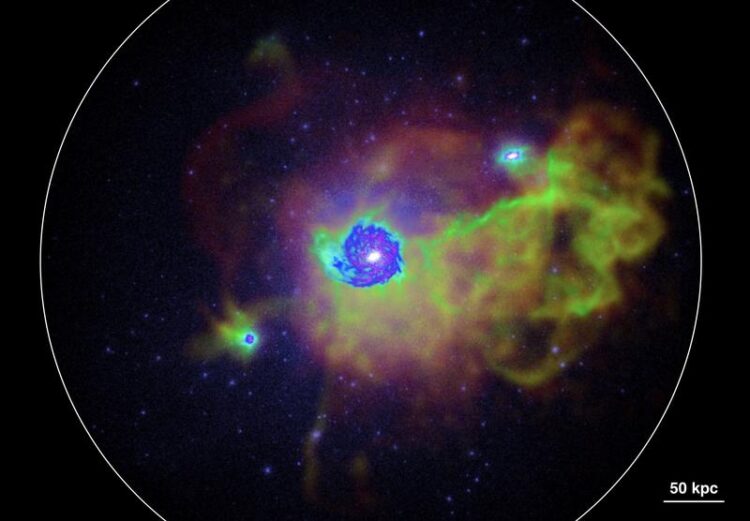How Nearby Galaxies Form their Stars

Wie ein Stern entsteht.
Robert Feldmann
UZH
How stars form in galaxies remains a major open question in astrophysics. A new UZH study sheds new light on this topic with the help of a data-driven re-analysis of observational measurements. The star-formation activity of typical, nearby galaxies is found to scale proportionally with the amount of gas present in these galaxies. This points to the net gas supply from cosmic distances as the main driver of galactic star formation.
Stars are born in dense clouds of molecular hydrogen gas that permeates interstellar space of most galaxies. While the physics of star formation is complex, recent years have seen substantial progress towards understanding how stars form in a galactic environment. What ultimately determines the level of star formation in galaxies, however, remains an open question.
In principle, two main factors influence the star formation activity: The amount of molecular gas that is present in galaxies and the timescale over which the gas reservoir is depleted by converting it into stars. While the gas mass of galaxies is regulated by a competition between gas inflows, outflows and consumption, the physics of the gas-to-star conversion is currently not well understood. Given its potentially critical role, many efforts have been undertaken to determine the gas depletion timescale observationally. However, these efforts resulted in conflicting findings partly because of the challenge in measuring gas masses reliably given current detection limits.
Typical star formation is linked to the overall gas reservoir
The present study from the Institute for Computational Science of the University of Zurich uses a new statistical method based on Bayesian modeling to properly account for galaxies with undetected amounts of molecular or atomic hydrogen to minimize observational bias. This new analysis reveals that, in typical star-forming galaxies, molecular and atomic hydrogen are converted into stars over approximately constant timescales of 1 and 10 billion years, respectively. However, extremely active galaxies (“starbursts”) are found to have much shorter gas depletion timescales. “These findings suggest that star formation is indeed directly linked to the overall gas reservoir and thus set by the rate at which gas enters or leaves a galaxy,” says Robert Feldmann, professor at the Center for Theoretical Astrophysics and Cosmology. In contrast, the dramatically higher star-formation activity of starbursts likely has a different physical origin, such as galaxy interactions or instabilities in galactic disks.
This analysis is based on observational data of nearby galaxies. Observations with the Atacama Large Millimeter/Submillimeter Array, the Square Kilometer Array and other observatories promise to probe the gas content of large numbers of galaxies across cosmic history. It will be paramount to continue the development of statistical and data-science methods to accurately extract the physical content from these new observations and to fully uncover the mysteries of star formation in galaxies.
Caption Figure 1:
Visualization of gas in and around a Milky-Way-like galaxy (center) in today’s Universe as predicted by a cosmological simulation run by the author. Dense, atomic and molecular hydrogen typically forms an extended disk, here seen in bluish-purple at the center of the image. Stars (white) form throughout the gas disk. Additional star formation may take place in satellite galaxies, here seen at the top right and bottom left positions. Hot, low density gas (green and red hues) can be found at large distances, out to the edge of the dark matter halo surrounding the main galaxy (white circle). The image also shows a large number of dark matter substructures (purple) most of which are devoid of gas and stars. (Illustration: Robert Feldmann, UZH)
Wissenschaftliche Ansprechpartner:
Prof. Robert Feldmann
Institute for Computational Science
University of Zurich
Tel. +41 44 63 55714
E-mail: feldmann@physik.uzh.ch
Originalpublikation:
Literature:
Robert Feldmann. The link between star formation and gas in nearby galaxies. Communications Physics, 7 December 2020. Doi: 10.1038/s42005-020-00493-0 https://rdcu.be/cbNUP
Media Contact
All latest news from the category: Physics and Astronomy
This area deals with the fundamental laws and building blocks of nature and how they interact, the properties and the behavior of matter, and research into space and time and their structures.
innovations-report provides in-depth reports and articles on subjects such as astrophysics, laser technologies, nuclear, quantum, particle and solid-state physics, nanotechnologies, planetary research and findings (Mars, Venus) and developments related to the Hubble Telescope.
Newest articles

Hubble Views the Dawn of a Sun-like Star
Looking like a glittering cosmic geode, a trio of dazzling stars blaze from the hollowed-out cavity of a reflection nebula in this new image from NASA’s Hubble Space Telescope. The…

Engineering a new color palette for single-molecule imaging
A new paper published in Nature Nanotechnology outlines a way to create dozens of new “colors” to multiplex single-molecule measurements. Researchers often study biomolecules such as proteins or amino acids…

Using solar energy to generate heat at high temperatures
The production of cement, metals and many chemical commodities requires extremely high temperatures of over a thousand degrees Celsius. At present, this heat is usually obtained by combusting fossil fuels:…





















